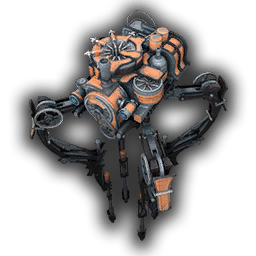| Automatons |
|---|

| |
| Cost | |
| 50 | |
| 100 | |
| 100 | |
| 1 | |
| Dismantle Value | |
| 50 | |
| 100 | |
| 100 | |
| 1 | |
Automatons are towering, autonomous, steam-powered robots with four long, thin legs. These machines are capable of staffing most buildings and will maintain themselves without player intervention once they've been given orders to "man" a building, returning to either the Generator or the nearest Steam Hub every so often to refuel. Unlike people, they can work almost continuously at all hours and are indifferent to the temperature. However, when automatons are first discovered/built, the building they are operating only runs at 60% efficiency. This efficiency rate can be increased to up to 100% across 3 technologies and a series of events, plus research bonuses to the building type.
Description[ | ]
Giant, quadruped, steam-powered behemoths of steel and gears with fiery Steam Cores for a beating heart, the automatons were the pinnacle of human engineering before the Great Winter and an unimaginable boon for your City that can be used to improve the economy and to ease the burden of hard labour from your wearied citizens. They’re an example of pragmatic and authentic steampunk technology, used to endure cold and ensure humanity’s chances of survival.
Acquiring[ | ]
While additional automatons can be built at a factory by engineers for a hundred wood, a hundred steel, fifty coal, and a steam core each (some research and events reduce the wood and steel cost), there are some events in the game that provide a free Automaton.
In the 'A New Home' scenario you can acquire a single automaton after the Steel Bridge scouting mission, you have option to disassemble the automaton for resources or program it to return to the city.
In 'The Arks' scenario, you start with an automaton and you can acquire an additional automaton after the Broken Automaton scouting mission, in which your scouts find a broken automaton and repair it before sending it back to the city.
Advantages[ | ]
- Automatons will work at all hours and all conditions, only stopping due to specific and rare events.
- They can be sent to harvest resources far from the town without forcing you to heat the area, although a road connection is still required.
- If you get the Engineer Automatons upgrade, they can be used to keep Workshops running day and night, so that you're always making research progress. This can also be used to staff the Factory itself, avoiding the nightly interruption in the production of further Automaton (this is only a benefit if you have the resource income to sustain production, however).
- They can be used in place of emergency shifts to avoid raising discontent.
Disadvantages[ | ]
- Automatons will almost always have lower efficiency in their workplace compared to people.
- Their round-the-clock hours of work almost invariable make up for this, however, as an automaton at 60% efficiency is still equivalent, in daily production, to 144% efficiency for workers on a normal 10-hour shift, or 102.9% efficiency for workers on an extended 14-hour shift. At the maximum 100% efficiency, this is equivalent to 240% efficiency for 10-hour shifts and 171.4% for 14-hour shifts.
- Their efficiency is not affected by Shrines or agitators, but they are affected by a Foreman, Engineer Apprentices, and Medic Apprentices.
- Building automatons depletes precious steam cores, reducing the number available with which to build more technologically advanced buildings.
- While Automatons can be upgraded, it will take time and resources that might be better used on other research.
- If your Generator shuts down, Automatons will be kept from refueling and quit working as a consequence. You may turn on the generator just long enough to keep them working, but no Coal is no go.
- They will shut down after a few hours in the On The Edge scenario, due to a lack of any Generator or Steam Hubs to refuel at. It is thus inadvisable to build any in this case.
Upgrades[ | ]
The following technologies affect automatons:
- Engineer Automatons - Allows automatons to be used at Workshops and Factories.
- Medical Automatons - Allows automatons to be used at Medical Posts and Infirmaries.
- Medical Automaton Integration - Increases efficiency by 20% at medical facilities.
- Automaton Integration - Increases efficiency by 10%.
- Automaton Integration II - Increases efficiency by 10%.
- Automaton Integration III - Increases efficiency by 10%.
- Streamlined Automatons - Reduces cost by 20 Wood and 20 Steel.
- Automaton Redesign - Reduces cost by 30 Wood and 30 Steel.
- Automaton Scouts - Allows automatons to be deploy as Scouts (only available in The Arks).
There are also a few events that can affect the efficiency of automatons:
- The Automaton Project can increase efficiency by up to 10% and decrease cost by up to 5%.
- The Automatons (Arc) can reduce efficiency by 10%.
Additional notes[ | ]
- An automaton's movement appears to be mostly cosmetic. The building they are assigned to will begin producing almost as soon as they are assigned to it, even if it takes them several in-game hours to actually arrive there. As long as an automaton does not get reassigned there refueling is purely cosmetic as they will keep on producing even if there animation does not show them on the building. However if an automaton is taken out of it's workplace it must finish it's refueling before it can start any new work.
- Automatons can refuel at any steam hub, even if turned off or not fully constructed.
- Automatons may be scrapped for resources, including a steam core, useful when labour is plentiful and a steam core is required elsewhere.
- Automatons dismantle for the same resources as they cost. This also can be used to rebuild automaton at a cheaper cost, earning the difference.
- The default 60% efficiency and a 24h shift are pretty much there to compensate for each other. An automaton working at 60% for 24 hours provides a total output of a full 100% shift lasting for 14.4 hours which is almost the same as you'd expect from your human workers if on extended shifts, and 44% better if the human workers are on the normal 10-hour shifts.
- Once upgrades come into play automatons leave a human shift in the dust. Automatons rise by ~50% (give or take based on event choices) of the baseline 14.4 hours and humans only rise by 20%.
- As such any advantage that can be outweighed by an extra 10-man shift on the same resource (such as the extra food production of a greenhouse compared to that of the hunters) is NOT worth spending a core on. And that pretty much cements the automatons place as the number one choice for core spending. Obvious exceptions are the things you cannot obtain at all without the cores, such as wall drills being the only available method of late game wood production.
- Automatons are capable of construction, and are arguably better at it than human workers, as the construction will begin immediately once a free automaton assigns itself to the site, unlike human workers who will not contribute to construction efforts until they have physically traveled to the location. However, automatons normally work constantly, so it is necessary to unassign an automaton for it to perform construction, which can be useful when a construction site is located far away from any human workers.
Gallery[ | ]
Trivia[ | ]
It’s unclear when or by whom these machines were invented, but it is clear that it was sometime before the Great Winter enveloped the Earth.
Our best guess is that Frostpunk’s timeline diverged from our timeline at a much earlier date: 1822. In 1822, the English mathematician Charles Babbage conceived of a steam-driven calculating machine that would be able to compute tables of numbers. The project, funded by the British government, only had limited success in our timeline, but in the world of Frostpunk, Babbage succeeded in mass producing the world's first difference engine. Jump forward to 1886, and through the combination of complex clockwork mechanisms, advanced difference/analytical engines and powerful steam-powered actuators known as steam cores, these metal behemoths were born.



